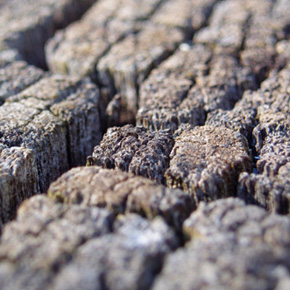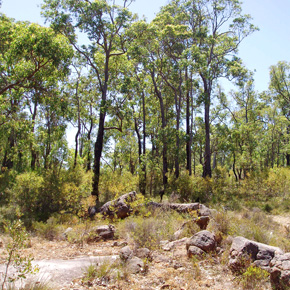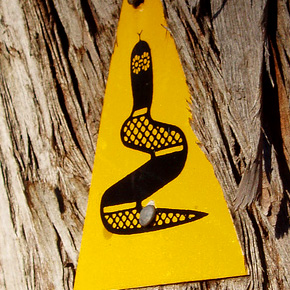The Bibbulmun
 Australia
Australia 963km/598mi
963km/598miPhoto by Mark Radford.
Overview
The Bibbulmun Track is a wonderful, and actually quite easy, adventure, covering nearly 1000 km of ground in the south-western corner of Western Australia, from Kalamunda (an outer suburb of Perth) through to the sizeable town of Albany on the south coast. (From Albany, it’s then easy enough to catch the coach back to Perth.) The first half of the Track runs mostly in a southerly direction through eucalyptus forest, some of the remaining trees spectacularly large. Here the way is often on old forestry roads and tracks. The second half of the track heads east, is more often a real footpath, and frequently passes through scrub and sand dunes and sometimes actually onto the beach. In this half you experience magnificent views of steep cliffs and of the wild sea beyond.
Accommodation
Every now and then the Track comes out of the bush and crosses remote roads, and at some of these points it leads through small towns where the long-distance walker can stay for the night and stock up on food. Some people book ahead, or organise food drops ahead, but I didn’t, and had no trouble on either front. I landed variously staying variously at a caravan park, a pub, a backpackers and a motel. There was always somewhere to stay, and each of the settlements made for an interesting break in routine.
All the way along the Track there are simple huts, initially (when travelling south, as most people do) once about every 10 km, but soon only about once every 20 km. This means that (unless you are unlucky enough to find a very full hut, or for some reason come to grief between huts) you don’t need to carry a tent, though you are advised to. Given that you will have quite a heavy pack because of carrying food, it’s quite nice not to have to carry a tent. I carried one, but only landed up using it in a couple of caravan parks, and inside a few of the huts, when the inner was very handy as a ‘mosquito net’.
The huts are fantastic, and they’re free. They all only three walls only and are open at the front, so they can be cold at night. I took a summer sleeping bag, thinking that would provide ample warmth in October/November, but I suffered during the early October nights and was lucky to be able to borrow a second summer sleeping bag, thereafter often sleeping with one bag inside the other. Apart from bunks or sleeping platforms (enough room for at least eight people a night, and sometimes more), each hut has a picnic table, a long drop toilet, and one or two water tanks. (Most of the northern huts also have a fireplace, while in the south open fires are prohibited.) The water tanks are crucial, since otherwise it would be difficult to source enough water for many stretches along the Track. Drinking from the tanks in the early morning and the evening, then carrying a relatively small amount while walking (I never needed to carry more than 2 litres), I never had any worries about. You are advised to boil all water or to use water purification tablets. I was carrying the tablets, but I never used them with the tank water and always felt okay.
Way Marking and Infrastructure
From the Bibbulmun Track foundation you can buy both the two-volume guide to the Track and a series of maps. I found the guide books (which include quite detailed maps) were all I needed and, in fact, quite often I consulted the book at the beginning of each day then looked at it while walking only if I needed to confirm my direction. I only lost my way briefly once, relying almost exclusively on the yellow triangular way marks, which are usually (but not always) placed as often as you need to be directed or reassured by them.
I flew to Western Australia specifically with the intention of walking the Track, even buying some packaged food items before getting into Australia from New Zealand. I arrived at Perth domestic airport in the depths of the night, crashed on the floor there for a few hours, then walked about 1.5 km to the nearest bust stop, from where I caught the day’s first bus to Kalamunda. Here I found there was a large supermarket right opposite the start of the Track!
Food
I started off with much more food than I needed, and therefore with a 26 kg pack, which was too much. In retrospect, I should have been carrying 20 kg at most, and some of the people I met were getting by with as little as 15 kg. The first stretch is the hardest in terms of supplies, since there is nowhere to restock until Dwellingup, which may take 14 days if you stop at every hut. In fact it only took me 9 days to reach Dwellingup, and I found that I had started with enough food to have lasted about 20 days. By the time you reach Dwellingup you know how much you need to eat each day and how many kilometres you can cover each day. You will hopefully have found out, by then, that you can walk 20 km a day without difficulty, because from here on, unless you are carrying a tent, you no longer have the option of overnighting at a hut about once every 10 km.
After Dwellingup there is never so long before the next store or supermarket – and, anyway, you have a much better overall idea of what you are doing. I found that every small town had enough food to meet my requirements, though sometimes there wasn’t a great deal of variety. I got tired of eating packets of tuna. Also, on the fuel front, I was travelling with a Trangia stove, for which I was always able to get more meths when I needed it.
When to Walk
The Track is always open, but everyone says it would be crazy to walk it in summer because of the heat. In the winter it can be pretty cold, so autumn and spring are definitely the best options, with spring being favoured by most people because there is then the added interest of flowering plants in bloom. I could hardly identify any of the flowers and didn’t feel I could afford the extra weight of nature guides, but one or two people I met could at least identify many orchids for me. I also spotted various animals, including wallabies and kangaroos, emus, and some lizards. I saw ten snakes in all, eight of them probably the highly venomous tiger snake, which can kill you but this never seems to happen, because (like yours) their tendency, unless you step on one, is to get the hell out of it. Everyone begins the track worried about snakes, but most people land up pretty blasé about them. I was more troubled by the ticks, getting about twenty on my body in the first few weeks (rapidly learning how to pull them off with tweezers), but meeting none thereafter.
Other
Most people do the walk in around fifty days. It took me fifty-five days, including a couple of rests. I wondered if I was a bit old, tackling it when sixty, but in fact most of the walkers I met were in the middle-age bracket and there were even a couple of 75-year olds. Looking through the log books in the huts, it seems that, on average, about one person a day completes the whole track, though in fact people aren’t evenly spread throughout the seasons, and you tend to bunch up into groups, sometimes deliberately so as to have company in the afternoons when you all meet up again at the next hut. You also meet people just doing a section of the Track, or coming in for a day walk. I never had a night entirely to myself (though could have, if I’d wanted to avoid people), but this was exceptional, even when walking (as I was) near the most popular time. A friend of mine had walked the track three years before (in 2008), only about three weeks earlier in the season, and was alone in a hut perhaps two out of every three nights. He also experienced a lot of rain, while I had hardly any for the first half of my walk.
I have called this an easy walk, because for me, apart from having too heavy a pack (which I could have avoided), the walk did not feel particularly demanding. There are some hills to climb (only in Australia would many of them be termed mountains) with rewarding views from the tops, but often the track is flat or flattish and generally the surface is good. Sometimes you might slip, and on the remarkable Pingerup Plains area the Track may be flooded, meaning you’re walking in water up to your knees. The demanding aspect of it is only that you have to adjust to doing a similar amount of walking, and following basically the same, simple routine, day after day for a substantial length of time. But, for me at least, this became a real pleasure, particularly given good scenery and, often, good company. And, failing that, there was usually a good book to read in the restful mid to late afternoons, once the day’s walking had been completed and before nightfall came. Most of the people I met were Australian, though the person I most often teamed up with was German. I was the only New Zealander, and surprisingly few Kiwis have heard of the track, let alone walked it. Many more walkers could be out there enjoying it!
Map
Books
A guide book is not essential because the route is so well marked, but they contain maps, accommodation listings and local history which is useful and can enrich your experience. You can buy the official guidebooks here.
More Information
Photo by Mark Radford.
Photo by Mark Radford.
Photo by Mark Radford.

 Designed by
Designed by
 Developed by
/
Developed by
/ Icons by
Icons by